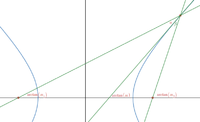I believe I was able to solve using calculus.
I did: Der(x^2/a^2)-Der(y^2/b^2)=Der(1)
Taking that equation I did the same but with the x0 and y0 for the points of the center: (x^2+xo)/a^2-(y^2+yo)/b^2=1
I then solved for y: y=b/a(x+xo)+yo
And this shows that beta and alpha are a ratio of each other.
Would this be correct?
I don't think what you did is correct, but your description is too vague to tell. We know the coordinates of the foci are:
[MATH]\left(\pm\sqrt{a^2+b^2},0\right)[/MATH]
And so the slope \(m_1\) of line \(PF_1\) is:
[MATH]m_1=\frac{y_0}{x_0+\sqrt{a^2+b^2}}[/MATH]
And the slope \(m_2\) of line \(PF_2\) is:
[MATH]m_2=\frac{y_0}{x_0-\sqrt{a^2+b^2}}[/MATH]
Now, the tangent line may be written:
[MATH]y=m\left(x-x_0\right)+y_0[/MATH]
Substituting for \(y\) in the equation of the hyperbola, we obtain:
[MATH]\frac{x^2}{a^2}-\frac{\left(m\left(x-x_0\right)+y_0\right)^2}{b^2}=1[/MATH]
We now have a quadratic in \(x\), which we should now work to arrange in standard form:
[MATH]b^2x^2-a^2\left(m\left(x-x_0\right)+y_0\right)^2=a^2b^2[/MATH]
[MATH]b^2x^2-a^2\left(m^2\left(x-x_0\right)^2+2my_0\left(x-x_0\right)+y_0^2\right)=a^2b^2[/MATH]
[MATH]b^2x^2-a^2\left(m^2\left(x^2-2x_0x+x_0^2\right)+2my_0\left(x-x_0\right)+y_0^2\right)=a^2b^2[/MATH]
[MATH]b^2x^2-a^2\left(m^2x^2-2m^2x_0x+m^2x_0^2+2my_0x-2my_0x_0+y_0^2\right)=a^2b^2[/MATH]
[MATH]b^2x^2-a^2m^2x^2+2a^2m^2x_0x-a^2m^2x_0^2-2a^2my_0x+2a^2my_0x_0-a^2y_0^2=a^2b^2[/MATH]
[MATH]\left(b^2-a^2m^2\right)x^2+2a^2m\left(mx_0-y_0\right)x-a^2\left(\left(mx_0-y_0\right)^2+b^2\right)=0[/MATH]
Now, having arranged the quadratic in standard form, we can equate the discriminant to zero, to find the value of \(m\), since the tangent line does not touch the hyperbola anywhere else.
[MATH]\left(2a^2m\left(mx_0-y_0\right)\right)^2-4\left(b^2-a^2m^2\right)\left(-a^2\left(\left(mx_0-y_0\right)^2+b^2\right)\right)=0[/MATH]
This reduces to:
[MATH]\left(a^2-x_0^2\right)m^2+2x_0y_0m-\left(b^2+y_0^2\right)=0[/MATH]
Applying the quadratic formula, we find:
[MATH]m=\frac{-2x_0y_0\pm\sqrt{(2x_0y_0)^2+4\left(a^2-x_0^2\right)\left(b^2+y_0^2\right)}}{2\left(a^2-x_0^2\right)}[/MATH]
[MATH]m=\frac{-x_0y_0\pm\sqrt{a^2b^2+a^2y_0^2-b^2x_0^2}}{a^2-x_0^2}[/MATH]
Now, since the point \(\left(x_0,y_0\right)\) is on the hyperbola, we know:
[MATH]\frac{x_0^2}{a^2}-\frac{y_0^2}{b^2}=1[/MATH]
And this can be arranged as:
[MATH]a^2b^2+a^2y_0^2-b^2x_0^2=0[/MATH]
Hence:
[MATH]m=\frac{x_0y_0}{x_0^2-a^2}[/MATH]
Using:
[MATH]a^2b^2+a^2y_0^2-b^2x_0^2=0[/MATH]
We find:
[MATH]x_0^2-a^2=\frac{a^2y_0^2}{b^2}[/MATH]
And so we may write:
[MATH]m=\frac{x_0y_0}{\dfrac{a^2y_0^2}{b^2}}=\frac{b^2x_0}{a^2y_0}[/MATH]
Now, let's find the slope using the calculus:
Implicitly differentiating the hyperbola with respect to \(x\), we find:
[MATH]\frac{2x}{a^2}-\frac{2y}{b^2}y'=0\implies y'=\frac{b^2x}{a^2y}[/MATH]
And so, at the point \(\left(x_0,y_0\right)\), we have:
[MATH]y'=\frac{b^2x_0}{a^2y_0}\quad\checkmark[/MATH]
Okay, we now have the slopes of all three lines, so consider the following diagram:

We know:
[MATH]\arctan\left(m_1\right)+\left(\pi-\arctan(m)\right)+\alpha=\pi\implies \alpha=\arctan(m)-\arctan\left(m_1\right)[/MATH]
[MATH]\arctan(m)+\left(\pi-\arctan\left(m_2\right)\right)+\beta=\pi\implies \beta=\arctan\left(m_2\right)-\arctan(m)[/MATH]
Next, consider the following identity:
[MATH]\arctan(a)-\arctan(b)=\arctan\left(\frac{a-b}{1+ab}\right)[/MATH]
Hence:
[MATH]\alpha=\arctan\left(\frac{m-m_1}{1+mm_1}\right)=\arctan\left(\frac{\dfrac{b^2x_0}{a^2y_0}-\dfrac{y_0}{x_0+\sqrt{a^2+b^2}}}{1+\dfrac{b^2x_0}{a^2y_0}\cdot\dfrac{y_0}{x_0+\sqrt{a^2+b^2}}}\right)[/MATH]
[MATH]\beta=\arctan\left(\frac{m_2-m}{1+mm_2}\right)=\arctan\left(\frac{\dfrac{y_0}{x_0-\sqrt{a^2+b^2}}-\dfrac{b^2x_0}{a^2y_0}}{1+\dfrac{b^2x_0}{a^2y_0}\cdot\dfrac{y_0}{x_0-\sqrt{a^2+b^2}}}\right)[/MATH]
To simplify, we find:
[MATH]\frac{\dfrac{b^2x_0}{a^2y_0}-\dfrac{y_0}{x_0+\sqrt{a^2+b^2}}}{1+\dfrac{b^2x_0}{a^2y_0}\cdot\dfrac{y_0}{x_0+\sqrt{a^2+b^2}}}=\frac{b^2x_0^2+b^2x_0\sqrt{a^2+b^2}-a^2y_0^2}{a^2x_0y_0+a^2y_0\sqrt{a^2+b^2}+b^2x_0y_0}=\frac{a^2b^2+b^2x_0\sqrt{a^2+b^2}}{\left(a^2+b^2\right)x_0y_0+a^2y_0\sqrt{a^2+b^2}}=\frac{b^2\left(a^2+x_0\sqrt{a^2+b^2}\right)}{y_0\sqrt{a^2+b^2}\left(\sqrt{a^2+b^2}x_0+a^2\right)}=\frac{b^2}{y_0\sqrt{a^2+b^2}}[/MATH]
Likewise, we find:
[MATH]\frac{\dfrac{y_0}{x_0-\sqrt{a^2+b^2}}-\dfrac{b^2x_0}{a^2y_0}}{1+\dfrac{b^2x_0}{a^2y_0}\cdot\dfrac{y_0}{x_0-\sqrt{a^2+b^2}}}=\frac{b^2}{y_0\sqrt{a^2+b^2}}[/MATH]
And so we may conclude:
[MATH]\alpha=\beta[/MATH]
Normally, we do not provide complete solutions, but I found this problem interesting, and once I started, I couldn't stop.


